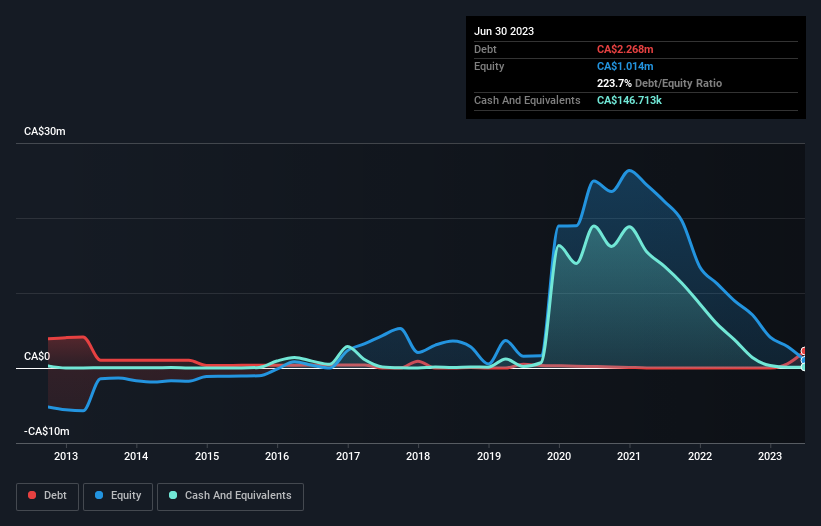Howard Marks put it nicely when he said that, rather than worrying about share price volatility, 'The possibility of permanent loss is the risk I worry about... and every practical investor I know worries about.' So it might be obvious that you need to consider debt, when you think about how risky any given stock is, because too much debt can sink a company. We note that dynaCERT Inc. (TSE:DYA) does have debt on its balance sheet. But the real question is whether this debt is making the company risky.
When Is Debt A Problem?
Debt assists a business until the business has trouble paying it off, either with new capital or with free cash flow. In the worst case scenario, a company can go bankrupt if it cannot pay its creditors. While that is not too common, we often do see indebted companies permanently diluting shareholders because lenders force them to raise capital at a distressed price. Of course, the upside of debt is that it often represents cheap capital, especially when it replaces dilution in a company with the ability to reinvest at high rates of return. When we think about a company's use of debt, we first look at cash and debt together.
See our latest analysis for dynaCERT
What Is dynaCERT's Debt?
You can click the graphic below for the historical numbers, but it shows that as of June 2023 dynaCERT had CA$2.27m of debt, an increase on none, over one year. However, it also had CA$146.7k in cash, and so its net debt is CA$2.12m.

How Strong Is dynaCERT's Balance Sheet?
According to the last reported balance sheet, dynaCERT had liabilities of CA$4.90m due within 12 months, and liabilities of CA$764.6k due beyond 12 months. Offsetting these obligations, it had cash of CA$146.7k as well as receivables valued at CA$267.7k due within 12 months. So its liabilities outweigh the sum of its cash and (near-term) receivables by CA$5.25m.
Of course, dynaCERT has a market capitalization of CA$70.4m, so these liabilities are probably manageable. However, we do think it is worth keeping an eye on its balance sheet strength, as it may change over time. There's no doubt that we learn most about debt from the balance sheet. But you can't view debt in total isolation; since dynaCERT will need earnings to service that debt. So if you're keen to discover more about its earnings, it might be worth checking out this graph of its long term earnings trend.
In the last year dynaCERT wasn't profitable at an EBIT level, but managed to grow its revenue by 140%, to CA$1.2m. So its pretty obvious shareholders are hoping for more growth!
Caveat Emptor
Despite the top line growth, dynaCERT still had an earnings before interest and tax (EBIT) loss over the last year. Indeed, it lost a very considerable CA$10m at the EBIT level. Considering that alongside the liabilities mentioned above does not give us much confidence that company should be using so much debt. So we think its balance sheet is a little strained, though not beyond repair. However, it doesn't help that it burned through CA$5.8m of cash over the last year. So suffice it to say we consider the stock very risky. When analysing debt levels, the balance sheet is the obvious place to start. But ultimately, every company can contain risks that exist outside of the balance sheet. We've identified 5 warning signs with dynaCERT (at least 3 which are a bit unpleasant) , and understanding them should be part of your investment process.
When all is said and done, sometimes its easier to focus on companies that don't even need debt. Readers can access a list of growth stocks with zero net debt 100% free, right now.
New: AI Stock Screener & Alerts
Our new AI Stock Screener scans the market every day to uncover opportunities.
• Dividend Powerhouses (3%+ Yield)
• Undervalued Small Caps with Insider Buying
• High growth Tech and AI Companies
Or build your own from over 50 metrics.
Have feedback on this article? Concerned about the content? Get in touch with us directly. Alternatively, email editorial-team (at) simplywallst.com.
This article by Simply Wall St is general in nature. We provide commentary based on historical data and analyst forecasts only using an unbiased methodology and our articles are not intended to be financial advice. It does not constitute a recommendation to buy or sell any stock, and does not take account of your objectives, or your financial situation. We aim to bring you long-term focused analysis driven by fundamental data. Note that our analysis may not factor in the latest price-sensitive company announcements or qualitative material. Simply Wall St has no position in any stocks mentioned.
About TSX:DYA
dynaCERT
Engages in the design, engineering, manufacture, testing, and distribution of transportable hydrogen generator aftermarket products in Europe, Canada, and internationally.
Slight risk with limited growth.
Market Insights
Community Narratives



